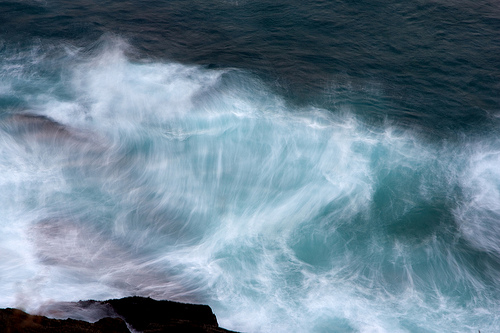FWP:
SETS == GENERATORS; KYA; SUBJECT?; SYMMETRY; WORDPLAY
BONDAGE: {1,5}
One pivot of this lovely, but bleakly undecideable, verse is kashākash , with its literal meaning of pulling and tugging (so much related to 'tension' and 'stress') and its extended meanings of anxiety, suffering, etc. (see the definition above). The other pivot is furṣat , with its opposite sense of ease and relief. For furṣat also implies the chance to move freely, and in the case of the wave, free movement means not only a kashākash , as the waves collide together, roil into one another, hurl each other about-- but also a zanjīr , as the waves move in their endless back-and-forth sloshing that basically gets them nowhere, like the pacing of a prisoner in his cell.
There's also the visual correlative: the curling crest of the wave assumes the round form of a shackle, and the series of cresting interlinked waves forms the sequential likeness of a chain.
The 'kya effect' gives us the usual three possible readings for the first line: a question (1a), an affirmative exclamation (1b), or a negative exclamation (1c). Then the principle of symmetry (if A=B, then B=A) gives us the two readings for the second line. We could also read saʿī-e āzādī as the subject of the first line: 'what would a struggle for freedom from the tensions achieve/do?' The same three 'kya effect' possibilities would still open up.
And how brilliantly, with how many piquant possibilities, the two lines come together! Compare {138,1}, which offers a similar range of possibilities through exactly the same sequence of devices ('kya' in the first line, symmetry in the second).
For a much lighter and more charming reading of the waves'
agitated behavior, see {116,9}.

Nazm:
That is, from the tensions of existence, the attempt at freedom can't work its will. The movement of water is exactly what becomes a shackle of bondage. That is, however much effort you make to become free from the tensions of the attachments/connections of existence, by that much your bondage keeps increasing, and the effort keeps being overpowered by the tensions. (179)
== Nazm page 179